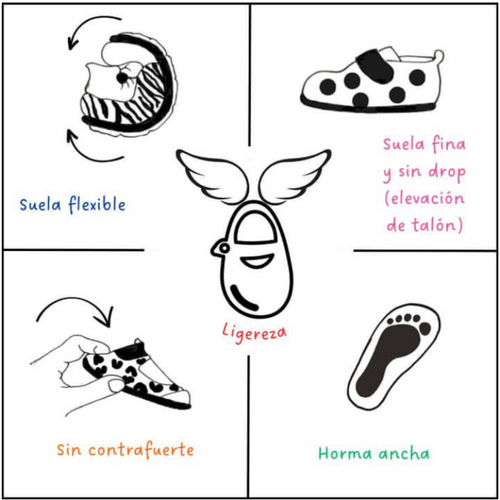Do you know what respectful or barefoot footwear is?
If you are new to the world of barefoot footwear, don't worry, here I will tell you everything you need to know.
The term "barefoot" comes from English and means "barefoot" , which gives us a clue as to what this type of footwear really means: the idea is to feel as if we were barefoot, that is, to walk or run without the artificial support offered by traditional footwear. The goal is to allow the foot to move freely, naturally and without restrictions, just as it would if we were not wearing anything.
But why is this type of footwear so important? And, above all, what are its characteristics and benefits for our feet, especially those of the little ones? Let's take a look.
Features of barefoot footwear
Barefoot footwear has a number of unique features that set it apart from conventional shoes. These features are essential to allow the foot to function as it should, without artificial restrictions. Below, I explain the main aspects that make this type of footwear so special:
✔️ Flexible sole
One of the main features of barefoot shoes is the flexibility of their sole. This flexibility allows the foot to move freely, adapting to different surfaces and providing a sensation very similar to that of walking barefoot. When we walk, our feet must be able to flex naturally, and a shoe with a flexible sole allows just that.
✔️ Thin sole without drop (heel lift)
In traditional shoes, the heel is often raised relative to the front of the foot, which is known as a drop . This artificial design limits the natural movement of the foot and can affect our posture and the way we walk. In barefoot shoes, the sole is thin and flat , meaning there is no heel lift. This allows the foot to be in a more natural position, promoting a more balanced stride and improving body alignment.
✔️ Without buttress
Another important aspect is that barefoot shoes do not have a heel counter . The heel counter is that rigid piece that is found in the heel of traditional shoes to give it support and structure. In barefoot shoes, by not having a heel counter, the foot can move freely, allowing the muscles and ligaments of the foot to strengthen naturally. This is especially beneficial in children, since their feet are in full development and need freedom of movement to grow correctly.
Benefits of respectful or barefoot footwear
Now that you know what features barefoot shoes have, you may be wondering: what benefits does it really bring to my feet (and those of my children)? Let's look at some of the most important ones:
-
Natural development of the feet
Barefoot footwear promotes natural foot development. As we walk barefoot or in respectful footwear, the muscles in the foot, as well as the ligaments and tendons, are naturally strengthened. This helps prevent long-term problems such as flat feet or hollow feet, as the feet work as they should: flexible, strong and adaptive . -
Improves posture
By not having a raised heel, barefoot shoes allow our posture to be more balanced. This is because the body, being more naturally aligned, distributes the weight better when walking. In addition, because the sole is thin and flexible, our feet can feel the terrain better and adjust our posture as needed. -
Greater mobility and feeling of freedom
Walking in respectful or barefoot footwear offers a feeling of freedom. The foot moves more naturally, which increases comfort and the feeling of being barefoot. For children, this freedom is essential, since motor development in their first years of life is closely linked to the ability to move fluidly and naturally. -
Better shock absorption
Although it may not seem like it, walking barefoot on hard surfaces such as the ground or asphalt has an additional benefit: better shock absorption . The foot is designed to absorb impact efficiently, but conventional shoes, being rigid, prevent the foot from acting correctly. With barefoot footwear, the foot can better adapt to different terrains and reduce the impact. -
Promoting balance and proprioception
Barefoot shoes promote proprioception, which is the ability to perceive and feel one's own body in space. By walking with a thin sole, the foot can better sense the terrain, which improves balance and stability. This is especially beneficial for children who are developing their motor and coordination skills.
Why choose respectful or barefoot footwear for your children?
For very young children, barefoot shoes are ideal because their feet are still developing and are particularly sensitive to the effects of incorrect footwear. Traditional shoes, which are often rigid or have a thick sole, can interfere with the natural development of the feet. By offering them barefoot shoes, we are allowing their feet to develop freely and healthily, with all the benefits that this entails.
In short, barefoot footwear is more than just a fad; it's a way to give our feet back their natural movement and ability to adapt to the environment. Not only is it a great option for adults, but it's also one of the best decisions you can make for the healthy development of your children's feet. If you're wondering whether they should try it, the answer is: definitely!

